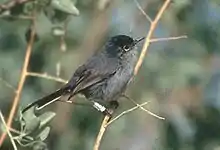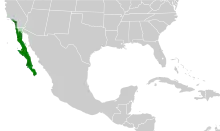California gnatcatcher
The California gnatcatcher (Polioptila californica) is a small 10.8 cm (4.3 in) long insectivorous bird which frequents dense coastal sage scrub growth. This species was recently split from the similar black-tailed gnatcatcher of the Sonoran and Chihuahuan deserts. This bird is often solitary, but joins with other birds in winter flocks.
| California gnatcatcher | |
|---|---|
 | |
| Scientific classification | |
| Kingdom: | Animalia |
| Phylum: | Chordata |
| Class: | Aves |
| Order: | Passeriformes |
| Family: | Polioptilidae |
| Genus: | Polioptila |
| Species: | P. californica |
| Binomial name | |
| Polioptila californica (Brewster, 1881) | |
 | |
Description
The male California gnatcatcher is dusky gray overall, distinguished only by its black crown and thin black beak. It has a long, thin black tail with narrow white tips and edges on the underside of the tail feathers. However, the male loses its plumage colors by winter and obtains a plumage color similar to the females. The female is similar to the male, but with a blue-gray instead of a black crown.
In its range from coastal Southern California south through Baja California and Baja California Sur, this inconspicuous non-migratory resident is most often seen flitting hastily into undergrowth, or heard giving its call, which sounds like a kitten's meow, a rising and falling zeeeeer, zeeeeer.
Habitat
In the northern part of its range (Southern California) this species was listed as Threatened by the United States Fish and Wildlife Service in 1993 due to increasing development in its habitat, coastal sage scrub (current loss of coastal sage scrub in U.S is estimated at 70 to 90 percent).[2] Critical habitat under the Endangered Species Act has been designated for the California gnatcatcher. This species is especially vulnerable as a metapopulation due to its small populations in a limited habitat often live in the prime land to be developed for housing and commerce that can be easily isolated and reduced in size.
Though some of its habitat has been saved in national forests and state parks, its population has been severely fragmented. There are, however, ongoing efforts to preserve more open land in southern California to help ensure that this species will not disappear from its former range. California gnatcatchers are a focal species in many regional habitat conservation planning efforts.
Ecology and reproduction
Monogamous pairs care for their brood of 3–5 eggs in cone-shaped nests. Brown-headed cowbirds are parasites that lay eggs in their nests.[3]
Footnotes
- BirdLife International (2012). "Polioptila californica". IUCN Red List of Threatened Species. 2012. Retrieved 26 November 2013.CS1 maint: ref=harv (link)
- Mock, P. (2004). "California Gnatcatcher (Polioptila californica)". The Coastal Scrub and Chaparral Bird Conservation Plan: a strategy for protecting and managing coastal scrub and chaparral habitats and associated birds in California. California Partners in Flight.
- "California Gnatcatcher (Polioptila californica)". Archived from the original on 26 December 2008.
References
- Atwood, J.L.; Bontrager, D.R. (2001). Poole, A.; Gill, F. (eds.). California Gnatcatcher (Polioptila californica). The Birds of North America. Philadelphia, PA: The Birds of North America, Inc.
- Mock, P.J. (2004). Unitt, Philip (ed.). California Gnatcatcher. San Diego County Bird Atlas. Vista, CA: San Diego Natural History Museum No. 39. Ibis Publishing Co. pp. 430–433. ISBN 978-0934797214.
External links
| Wikimedia Commons has media related to Polioptila californica. |
| Wikispecies has information related to Polioptila californica. |
